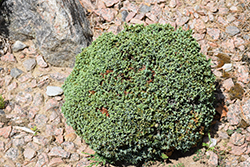>> Home
Blue Pygmy Juniper
Juniperus horizontalis 'Blue Pygmy'
Height: 6 inches
Spread: 24 inches
Sunlight:
![]()
![]()
Hardiness Zone: 3a
Brand: Iseli
Description:
A tiny and dense groundcover evergreen, featuring fine blue-green foliage which takes on a purplish tinge in winter; extremely slow growing and ground-hugging; very adaptable and hardy; excellent for small garden areas or trailing over walls
Ornamental Features
Blue Pygmy Juniper is a dwarf conifer which is primarily valued in the garden for its broadly spreading habit of growth. It has attractive bluish-green evergreen foliage. The tiny scale-like sprays of foliage are highly ornamental and remain bluish-green throughout the winter. It produces blue berries from late spring to late winter.
Landscape Attributes
Blue Pygmy Juniper is a dense multi-stemmed evergreen shrub with a ground-hugging habit of growth. It lends an extremely fine and delicate texture to the landscape composition which should be used to full effect.
This is a relatively low maintenance shrub, and is best pruned in late winter once the threat of extreme cold has passed. Deer don't particularly care for this plant and will usually leave it alone in favor of tastier treats. It has no significant negative characteristics.
Blue Pygmy Juniper is recommended for the following landscape applications;
- Mass Planting
- Rock/Alpine Gardens
- Border Edging
- General Garden Use
- Groundcover
Planting & Growing
Blue Pygmy Juniper will grow to be only 6 inches tall at maturity, with a spread of 24 inches. It tends to fill out right to the ground and therefore doesn't necessarily require facer plants in front. It grows at a slow rate, and under ideal conditions can be expected to live for approximately 30 years.
This shrub does best in full sun to partial shade. It is very adaptable to both dry and moist growing conditions, but will not tolerate any standing water. It is considered to be drought-tolerant, and thus makes an ideal choice for a low-water garden or xeriscape application. It is not particular as to soil type or pH. It is highly tolerant of urban pollution and will even thrive in inner city environments. This is a selection of a native North American species.

